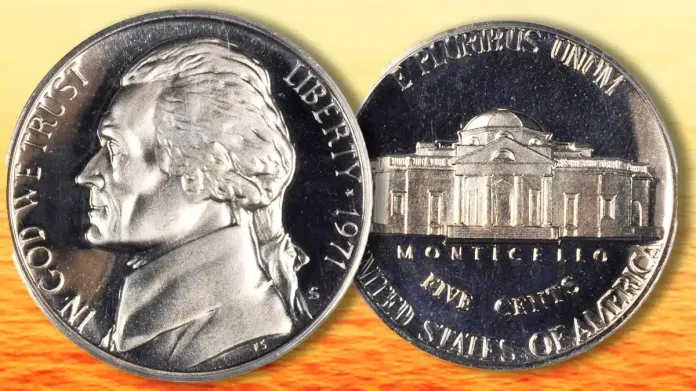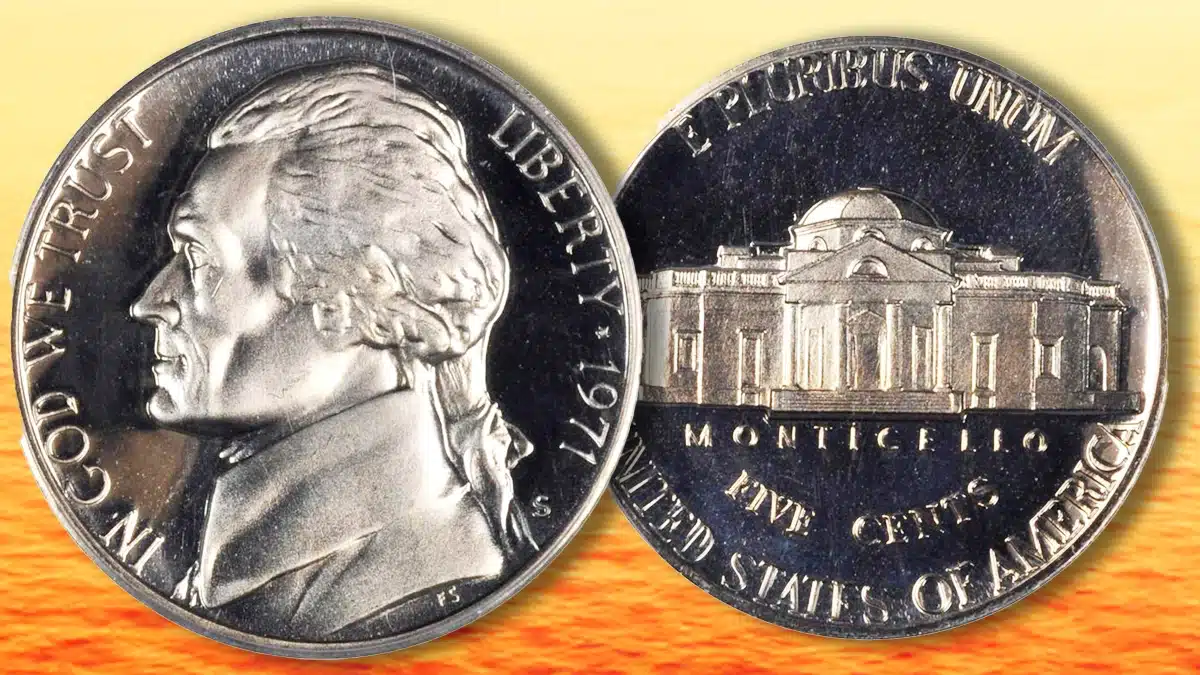
By Charles Morgan and Hubert Walker for CoinWeek Notes …..
By late 1970, the Jefferson Nickel Proof master dies had become severely worn and lacked fine detail. To correct the issue, the United States Mint set out to create new masters to restore Felix Schlag’s iconic design. During the Mint’s re-engraving process, both Thomas Jefferson’s portrait and the reverse image of Monticello were touched up. The Mint also strengthened the design by widening the rim slightly. As a result of this recutting and redesigning, the 1971-S nickel has a large number of varieties. The obverse has one named ODV-021, where the “TR” in trust is slightly thinner than normal. For the reverse, there are two varieties: RDV-005 and RDV-006. These RDVs refer to the redesigned Monticello. On RDV-005, the rooftop railings of Monticello are considered low relief, whereas on the 006 they are much stronger.
According to Variety Vista, one of the most comprehensive databases of coin varieties, there are 10 DDOs and 34 DDRs for the San Francisco Mint alone. In 1953, 1954, and from 1968-1973, the mint used the Tall style (MMS-005) mintmark. After ’73, the Mint returned to the MMS-002 or “Trumpet Tail”-style mintmark.
Starting in 1971, San Francisco stopped producing nickels for general circulation. In the second edition of A Guidebook of Buffalo and Jefferson Nickels (2017), Q. David Bowers states that the 1971-S was the first San Francisco five-cent piece since 1878 to be struck in Proof finish only. All other intervening issues had a circulation strike component. Since 1971, all nickels struck in San Francisco have been Proofs.
Due to massive mintages, rarity in modern coins is usually a byproduct of condition, variety, or mint error. One such example is the 1971 “No S” Jefferson Nickel, a standard Proof 1971 nickel in all but one way: it lacks the “S” mintmark. While the San Francisco Mint did strike the coins, the Philadelphia Mint was responsible for producing the dies. By mistake, they sent an incomplete die that was used briefly until the error was discovered. “No S” nickels are the only examples in the entire series without the proper mintmark and Mint officials estimate that 1,655 examples were accidentally released as part of the 1971 Proof Sets that year.
What Is the 1971-S Jefferson Nickel Worth?
While the vast majority of 1971-S nickels are worth no more than a few cents over face value, examples in higher grades do sell for more. The typical coin found in an undisturbed Proof Set will grade between PR65 and PR67. Loose Proof coins that would grade up to about PR65 at a professional service like CACG, NGC, or PCGS routinely sell for between 50¢ and $1. Better-grade Proofs sell for slightly more. A spate of recent eBay sales shows prices of $5 being typical for certified examples in PR69. To date, NGC has not graded a single 1971-S nickel Proof 70. PCGS has reported just one example at this level.
The “No S” error type, however, is much more valuable, with even low-grade examples worth upwards of $700 to $800. Higher-grade examples, between PR67 and PR68+, regularly hammer for $1,000 to $1,500. An NGC-graded PR69 even brought in a record $2,070 in the January 2012 Heritage FUN Signature Auction.
* * *
Market Data and Noteworthy Specimens
Top Population: PCGS PR70 (1, 2/2025), NGC PF69UCAM (181, 2/2025), and CAC N/A (, 2/2025).
- PCGS PR69DCAM #84188562: eBay, February 6, 2025 – $129.95.
- NGC PF69UCAM #3567233-073: eBay, January 31, 2025 – $115.55.
- PCGS PR69DCAM #48850688: GreatCollections, August 25, 2024, Lot 1640864 – View.
- NGC PF69UCAM #3567233-121: Heritage, May 9, 2023, Lot 23369 – $69.
- PCGS PR69DCAM #15578152: “MKJ Collection,” Heritage, June 8, 2013, Lot 7577 – $1,527.50; “The George “Buddy” Byers Buckeye Collection,” Stack’s Bowers, August 16, 2021, Lot 2177 – $132.
- PCGS PR69DCAM #42290639: DLRC, August 8, 2021, Lot 5040 – $100.
- PCGS PR69DCAM #14527982: “The Maltese Collection,” Heritage, October 20, 2020, Lot 25452 – $99.
- NGC PF69UCAM #3567233-104: Heritage, June 30, 2020, Lot 21083 – $84.
- NGC PF69UCAM #3567233-080: Heritage, June 30, 2020, Lot 21082 – $84.
- NGC PF69UCAM #3567233-049: Heritage, June 30, 2020, Lot 21081 – $84.
- PCGS PR69DCAM #21789868: “Steve Strom Collection,” Heritage, November 5, 2017, Lot 21108 – $79. Steve Strom Collection on label.
- PCGS PR69DCAM #30745465: Heritage, April 16, 2017, Lot 25076 – $99.
- PCGS PR69DCAM #15578144: Heritage, August 9, 2017, Lot 23742 – $188.
- NGC PF69UCAM #3567233-039: Heritage, May 24, 2016, Lot 27655 – $223.25.
- PCGS PR69DCAM #09207360: Heritage, September 28, 2013, Lot 7567 – $705.
* * *
Design
Obverse:
A left-facing bust of President Thomas Jefferson, including a colonial-era pigtail and strikingly similar in detail to the profile of Jean-Antoine Houdon’s 1789 bust, takes up most of the obverse. The top of his head almost touches the rim, and the barest of truncations is visible at the bottom where Jefferson’s left shoulder meets the edge of the coin. The motto IN GOD WE TRUST arcs clockwise along most of the length of the left side of the coin, starting from Jefferson’s chest and extending to his hairline. The word LIBERTY and the date 1971 run clockwise along the right side behind Jefferson. A small five-pointed star divides the two inscriptions. A small S mintmark appears at the bottom right of Jefferson’s portrait.
Reverse:
The reverse features a front view of Monticello, Jefferson’s mansion near Charlottesville, Virginia. The polymath Jefferson designed the neoclassical building himself, based on architectural principles from the Italian Renaissance; the name “Monticello” comes from the Italian for “mound” or “little mountain”. The building loses much of its dimensionality in the flattened rendering, but the octagonal nature of the dome can still be interpreted, and better strikes reveal significant detail in the steps and portico.
Atop the reverse is the motto E PLURIBUS UNUM (“Out of Many, One”). The name MONTICELLO–the placement of which on the coin was one of the revisions forced upon designer Felix Schlag by the Mint–is found in a straight line immediately under the building; the positions and spacing of the other inscriptions had to be adjusted to make room for it. The denomination FIVE CENTS forms a gently curving line beneath that, and the inscription UNITED STATES OF AMERICA runs counterclockwise along the bottom edge of the coin.
Interestingly, Schlag’s initials did not appear on a Jefferson nickel until 1966.
Edge:
The edge of the 1971-S Jefferson Nickel is plain or smooth, as it is on all Jefferson Nickels.
Designer
Felix Schlag was born in Frankfurt, Germany in 1891. After receiving an education at the Munich University of Fine Arts, he moved to the United States in 1929. Schlag died in 1974. Yet while he did win numerous art contests and commissions throughout much of the remainder of his life, the Jefferson Nickel was his only coin design.
Coin Specifications
| Country: | United States of America |
| Year of Issue: | 1971 |
| Denomination: | Five Cents (USD) |
| Mintmark: | S (San Francisco) |
| Mintage: | 3,220,733 |
| Alloy: | .750 copper, .250 nickel |
| Weight: | 5.00 g |
| Diameter: | 21.21 mm |
| Edge: | Plain |
| OBV Designer: | Felix Schlag |
| REV Designer: | Felix Schlag |
| Quality: | Proof |
* * *


